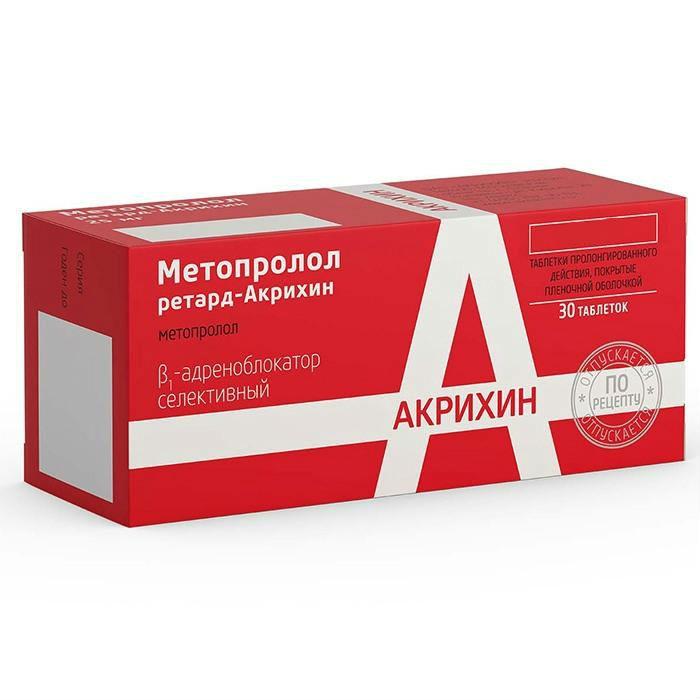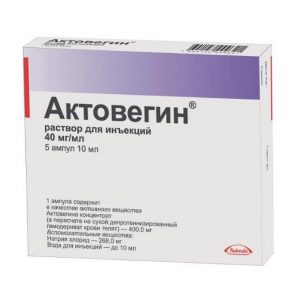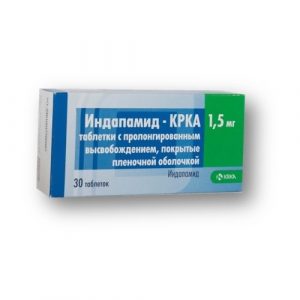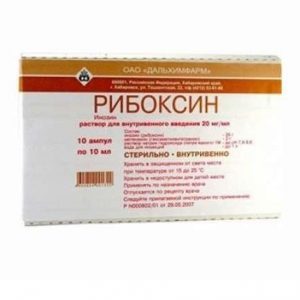Description
Latin name
METOPROLOL RETARD-AKRIKHIN
packaging 10 pcs – blister packs (3) – packs of cardboard.
Indications
arterial hypertension (as monotherapy or in combination with other antihypertensive agents)
coronary heart disease: myocardial infarction (secondary prophylaxis – complex therapy), prophylaxis of angina pectoris
cardiac arrhythmias (supraventricular) therapy)
prevention of migraine attacks.
Contraindications
hypersensitivity to metoprolol or other components of the drug, other beta-adrenoblockers
cardiogenic shock
atrioventricular block (AV) II-III degree
sard syndrome cardiac weakness srdklard cardiomyopathy srdlkrd cardiomyopathy hypotension (in case of use for secondary prophylaxis of myocardial infarction – systolic blood pressure less than 100 mm Hg, heart rate less than 45 beats / min)
lactac period ii (see “Pregnancy and lactation”)
simultaneous administration of monoamine oxidase inhibitors (MAO) or simultaneous intravenous administration of verapamil (see Interaction with other drugs )
under 18 years of age (efficacy and safety not established)
lactose intolerance, lactase deficiency or glucose-galactose malabsorption.
Use during pregnancy and lactation
During pregnancy, it is prescribed taking into account the ratio of the benefits to the mother and the risk to the fetus (due to the development of the fetus bradycardia, arterial hypotension, hypoglycemia).
At the same time, they closely monitor, especially the development of the fetus. It is necessary to monitor newborns within 48-72 hours after delivery.
The effect of metoprolol on a newborn, while breastfeeding has not been studied, therefore, women taking Metoprolol-Acre should stop breast-feeding.
Composition
One tablet contains:
active substance:
metoprolol tartrate in terms of 100% substance – 25 mg
excipients:
lactose monohydrate,
silicon dioxide colloidal,
potato starch,
povidone,
carboxymethyl starch sodium,
magnesium stearate.
Dosage and administration
Tablets are taken orally during or immediately after a meal, do not chew, drink a small amount of liquid. Arterial hypertension. The initial daily dose is 50-100 mg in 1-2 doses (morning and evening). With an insufficient therapeutic effect, the daily dose can be gradually increased to 100-200 mg and / or additional prescription of other antihypertensive agents. The maximum daily dose of 200 mg.
Angina pectoris, arrhythmias, prevention of migraine attacks. 100-200 mg per day in two divided doses (morning and evening).
Secondary prevention of myocardial infarction. 200 mg per day in two divided doses (morning and evening).
Hyperthyroidism. 50 mg 2 times a day (morning and evening).
In elderly patients, with impaired renal function, as well as with the need for hemodialysis, the dose is not changed. In case of impaired liver function, the dose should be reduced depending on the clinical condition.
Side effects
From the central nervous system: increased fatigue, weakness, headache, slowing down the speed of mental and motor reactions. Rarely – paresthesia in the extremities (in patients with “intermittent” lameness and Raynaud’s syndrome), depression, anxiety, decreased attention, drowsiness, insomnia, “nightmare” dreams, confusion or short-term memory impairment, muscle weakness.
On the part of the sensory organs: rarely – decreased vision, decreased secretion of lacrimal fluid, dry and sore eyes, conjunctivitis, tinnitus.
From the cardiovascular system: sinus bradycardia, palpitations, decreased blood pressure, orthostatic hypotension (dizziness, sometimes loss of consciousness). Rarely, a decrease in myocardial contractility, a temporary aggravation of the symptoms of chronic heart failure (edema, swelling of the feet and / or lower legs, shortness of breath), arrhythmias, the manifestation of angiospasm (increased peripheral circulation disturbance, cooling of the lower extremities, Raynaud’s syndrome), myocardial conduction disturbance.
From the digestive system: nausea, vomiting, abdominal pain, dry mouth, diarrhea, constipation, taste change.
From the skin: urticaria, pruritus, rash, exacerbation of psoriasis, psoriasis-like skin reactions, flushing of the skin, exanthema, photodermatosis, increased sweating, reversible alopecia.
From the respiratory system: nasal congestion, difficulty breathing out (bronchospasm when prescribed in high doses, loss of selectivity and / or in predisposed patients), shortness of breath.
From the endocrine system: hypoglycemia (in patients receiving insulin), rarely – hyperglycemia (in patients with insulin-dependent diabetes mellitus).
Laboratory indicators: rarely – thrombocytopenia (unusual bleeding and hemorrhage), agranulocytosis, leukopenia, increased activity of “liver” enzymes, very rarely – Hyperbilirubinemia.
Influence on the fetus: intrauterine growth retardation, hypoglycemia, and bradycardia are possible.
Other: pain in the back or joints, like all beta-blockers, in isolated cases it can cause a slight increase in body weight, a decrease in libido and / or potency.
Drug Interaction
Concomitant use with monoamine oxidase (MAO) inhibitors is not recommended due to a significant increase in antihypertensive activity. The interval between treatment with MAO inhibitors and metoprolol should be at least 14 days.
Simultaneous administration of verapamil may provoke cardiac arrest.
Simultaneous administration of nifedipine results in a significant decrease in blood pressure.
Inhalation anesthesia (hydrocarbon derivatives) increases the risk of myocardial function suppression and the development of hypotension.
Beta-adrenomimetics, theophylline, cocaine, estrogens (sodium retention), indomethacin and other non-steroidal anti-inflammatory drugs (sodium retention and blocking of prostaglandin synthesis by the kidneys) all attenuate the antihypertensive effect.
There is an increase in the depressant effect on the central nervous system – with ethanol summation of the cardio-depressive effect – with anesthesia, an increase in the risk of peripheral blood flow disorders – with ergot alkaloids.
When taken together with hypoglycemic agents for ingestion, it is possible to reduce their effect with insulin – increase the risk of hypoglycemia, increase its severity and lengthen, masking of some symptoms of hypoglycemia (tachycardia, sweating, high blood pressure).
When combined with antihypertensive drugs, diuretics, nitroglycerin or blockers of “slow” calcium channels, a sharp decrease in blood pressure may develop (special caution is required when combined with prazosin) increase in the severity of the reduction of the frequency of cardiac contractility , antiarrhythmic agents (amiodarone), reserpine, methyldopa, clonidine, guanfacine, general anesthesia and cardiac agents my glycosides.
If metoprolol and clonidine are taken at the same time, with the withdrawal of metoprolol, clonidine is canceled after a few days (due to the risk of cancellation syndrome).
Inductors of liver microsomal enzymes (rifampicin, barbiturates) lead to increased metabolism of metoprolol, to a decrease in its concentration in blood plasma and to a decrease in effect. Inhibitors (cimetidine, oral contraceptives, phenothiazines) – increase the concentration of metoprolol in plasma.
Allergens used for immunotherapy or allergen extracts for skin tests when used together with metoprolol increase the risk of systemic allergic reactions or anaphylaxis, iodine-containing X-ray contrast agents for I / O administration increase the risk of anaphylactic reactions.
Reduces the clearance of xanthine (except for dipyllin), especially with initially increased theophylline clearance under the influence of smoking. Reduces lidocaine clearance, increases plasma concentration of lidocaine.
Strengthens and prolongs the effect of antidepolarizing muscle relaxants and prolongs the anticoagulant effect of coumarins.
When combined with ethanol, there is an increased risk of a marked decrease in blood pressure.
Overdose
Symptoms:
severe sinus bradycardia, dizziness, vomiting, cyanosis, pronounced blood pressure, arrhythmias, ventricles until the development of complete transverse blockage and cardiac arrest), cardialgia. The first signs of overdose manifest themselves in 20 min -2 hours after taking the drug.
Treatment:
gastric lavage and absorption absorption symptomatic therapy: with a marked decrease in blood pressure, the patient should be in the position of Trendelenburg in case of excessive reduction of blood pressure, bradycardia and heart failure – in / in, with an interval of 2-5 minutes, beta-adrenomimetics – until the desired effect is achieved or in / in 0, 5-2 mg atropine sulfate. In the absence of a positive effect – dopamine, dobutamine or norepinephrine (norepinephrine).
As a follow-up, it is possible to administer 1-10 mg of glucagon, install a transvenous intracardiac pacemaker. At bronchospasm it is necessary to enter in / in beta2-adrenomimetics. Metoprolol is poorly excreted by hemodialysis.
Storage conditions
In a dry, dark place at a temperature of no higher than 25 ° C.
Keep out of the reach of children.
Active ingredient
Metoprolol
Terms and conditions
prescription
Dosage form
tablets prolong.
Possible product names
Metoprolol retard-Akrikhin tablets 25 mg 30 pcs




